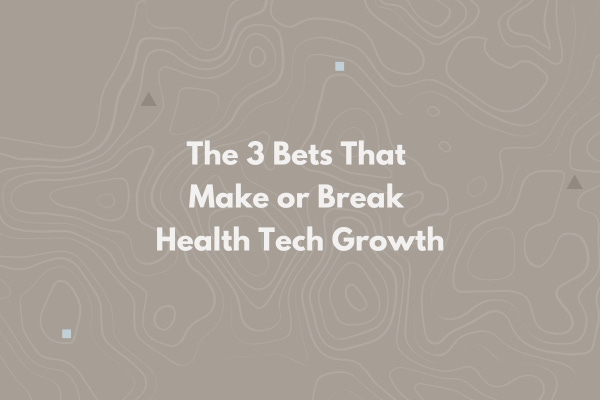The 3 Bets That Make or Break Health Tech Growth
Every serious growth plan comes down to a few core bets:
You’re betting the market is ready.
You’re betting the buyer will act.
You’re betting your team can execute the next phase.
Get those right, and things move faster. Miss one, and even the best product starts feeling stuck.
Over the last 15 years, I’ve worked with health tech vendors at nearly every stage. From early startups to PE-backed growth platforms, the pattern is consistent: Momentum doesn’t simply come from better execution. It comes from getting clear on the bets the business is built on and adjusting fast when one stops working.
These aren’t random blind spots. In fact, they tend to show up in sequence.
First, you bet on the market
Then, you bet on the buyer
Then, you bet on your team
Each one marks a stage of growth. Ignore it, and it becomes the hidden drag that slows everything you're trying to scale.
1. Early Stage: Betting the Market Is Ready
Common Vendor Response
Early signals feel good. Buyers are curious. You’re getting attention at conferences. A few RFPs pop up. One or two prospects are open to a pilot.
It feels like traction. It looks like momentum. Then things slow down.
Champions disappear after “socializing it internally”
Prospects say “circle back next year” or ghost altogether
Deals die in procurement
What It Actually Means
You’re early. And in healthcare, being early doesn’t mean you’re ahead. It means you’ll be stuck doing market education while burning through team energy and founder credibility. Most vendors aren’t failing because the product is off. They’re failing because urgency doesn’t exist, and no one is admitting it.
How the Best Vendors Solve It
They qualify against action, not enthusiasm. If budget isn’t moving or decision-makers aren’t leaning in, it’s not a real opportunity
They tie their message to real pressure: like Stars bonuses, RADV audits, delegated risk performance, or retention metrics.
They lead with a wedge use case that solves one urgent problem and clears a clean path to contract.
This stage isn’t about how innovative your solution is. It’s about whether the market feels pressure to act right now.
2. Mid-Stage: Betting the Buyer Can Say Yes
Common Vendor Response
You’ve landed some early wins. The product is validated, and buyers “get it.” You’re starting to aim bigger: more plans, more logos, more revenue.
But suddenly, deals feel heavier.
One buyer nods, but can’t bring others along
Internal handoffs stall momentum
Conversations loop without clear next steps
What It Actually Means
You’ve entered the complex middle: selling into orgs where no one person can say yes, but plenty of people can say no. You’re not losing on value. You’re losing on power dynamics, unclear ownership, and misread org charts.
How the Best Vendors Solve It
They identify all decision-makers early and build buy-in across functions, not just with one champion
They treat friction as a signal. Who's not in the room yet? Where does the budget actually sit? What killed similar deals before?
They arm champions with clear, tailored language that speaks to finance, ops, and compliance (not just the risk adjustment, QI, etc, teams).
At this stage, it’s not about who likes your solution. It’s about who can move it forward and whether your process makes that easy or hard.
3. Scaling Stage: Betting the Team Can Scale
Common Vendor Response
Early wins came from hustle. A few high performers pulled their weight. The founder stepped in to close deals. Now you’ve got more reps, a VP, Sales, maybe a RevOps and things are... slower.
Messaging varies wildly across the team
New hires can’t ramp
Internal friction grows as nobody agrees on who owns what
Forecasts look good until the last two weeks of the quarter
What It Actually Means
The org was built for an earlier phase, and now it’s holding growth back. Rarely can you scale early-stage momentum with the same team that got you there. And you can’t manage real complexity with leaders from large vendors who’ve never had to build the system themselves.
How the Best Vendors Solve It
They define clear roles, handoffs, and ownership so nothing falls through
They hire to solve real execution gaps, not to impress the board
They hire operators who build from scratch and not polished execs who only know how to run someone else's system
You’re not just betting on individuals. Growth reveals what your team can handle. If they weren’t built to scale, the cracks show fast.
Final Thought
When you're in build mode (juggling deals, pushing product, keeping investors aligned), it’s easy to confuse activity with progress. Everything’s moving. But it’s not always clear what’s actually working, or why growth feels harder than it should.
That’s where these three bets come in.
Friction doesn’t always appear obvious. It shows up as slippage in the pipeline, new hires who can’t get traction, or meetings that go nowhere. If you don’t name what you’re really betting on, you end up treating symptoms instead of solving the real problem.
The teams that scale aren’t perfect. But they get clear faster. They adjust before growth stalls. And they make fewer assumptions about what’s working and why.
Get clear on the bet. Make the next move count. You got this.
🔒 Like This? Upgrade to a paid Subscription.
The free newsletter covers the big ideas. Paid subscribers get the full breakdowns, including client-tested strategy, behind-the-scenes examples, and deeper thinking you won’t find anywhere else.
→ [Become a Paid Subscriber]
About the Author
Ryan Peterson writes Upward Growth, where he shares practical insights on selling health tech into the payor market. With 15+ years in healthcare growth leadership, he focuses on helping vendors translate their value into traction with health plans.
🟦 Connect with him on LinkedIn.


